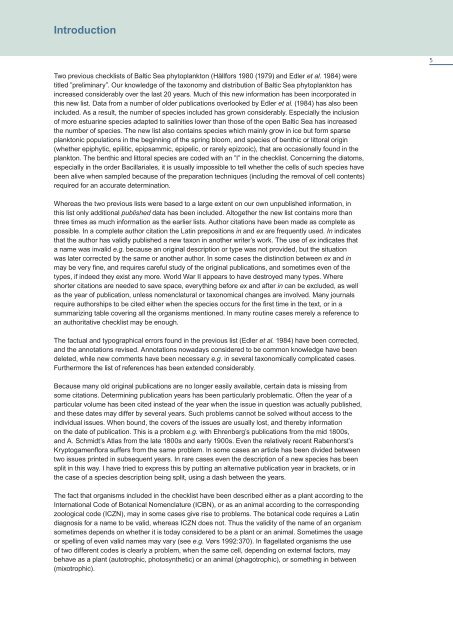Checklist of Baltic Sea Phytoplankton Species - Helcom
Checklist of Baltic Sea Phytoplankton Species - Helcom
Checklist of Baltic Sea Phytoplankton Species - Helcom
You also want an ePaper? Increase the reach of your titles
YUMPU automatically turns print PDFs into web optimized ePapers that Google loves.
Introduction<br />
Two previous checklists <strong>of</strong> <strong>Baltic</strong> <strong>Sea</strong> phytoplankton (Hällfors 1980 (1979) and Edler et al. 1984) were<br />
titled ”preliminary”. Our knowledge <strong>of</strong> the taxonomy and distribution <strong>of</strong> <strong>Baltic</strong> <strong>Sea</strong> phytoplankton has<br />
increased considerably over the last 20 years. Much <strong>of</strong> this new information has been incorporated in<br />
this new list. Data from a number <strong>of</strong> older publications overlooked by Edler et al. (1984) has also been<br />
included. As a result, the number <strong>of</strong> species included has grown considerably. Especially the inclusion<br />
<strong>of</strong> more estuarine species adapted to salinities lower than those <strong>of</strong> the open <strong>Baltic</strong> <strong>Sea</strong> has increased<br />
the number <strong>of</strong> species. The new list also contains species which mainly grow in ice but form sparse<br />
planktonic populations in the beginning <strong>of</strong> the spring bloom, and species <strong>of</strong> benthic or littoral origin<br />
(whether epiphytic, epilitic, epipsammic, epipelic, or rarely epizooic), that are occasionally found in the<br />
plankton. The benthic and littoral species are coded with an ”l” in the checklist. Concerning the diatoms,<br />
especially in the order Bacillariales, it is usually impossible to tell whether the cells <strong>of</strong> such species have<br />
been alive when sampled because <strong>of</strong> the preparation techniques (including the removal <strong>of</strong> cell contents)<br />
required for an accurate determination.<br />
Whereas the two previous lists were based to a large extent on our own unpublished information, in<br />
this list only additional published data has been included. Altogether the new list contains more than<br />
three times as much information as the earlier lists. Author citations have been made as complete as<br />
possible. In a complete author citation the Latin prepositions in and ex are frequently used. In indicates<br />
that the author has validly published a new taxon in another writer’s work. The use <strong>of</strong> ex indicates that<br />
a name was invalid e.g. because an original description or type was not provided, but the situation<br />
was later corrected by the same or another author. In some cases the distinction between ex and in<br />
may be very fi ne, and requires careful study <strong>of</strong> the original publications, and sometimes even <strong>of</strong> the<br />
types, if indeed they exist any more. World War II appears to have destroyed many types. Where<br />
shorter citations are needed to save space, everything before ex and after in can be excluded, as well<br />
as the year <strong>of</strong> publication, unless nomenclatural or taxonomical changes are involved. Many journals<br />
require authorships to be cited either when the species occurs for the fi rst time in the text, or in a<br />
summarizing table covering all the organisms mentioned. In many routine cases merely a reference to<br />
an authoritative checklist may be enough.<br />
The factual and typographical errors found in the previous list (Edler et al. 1984) have been corrected,<br />
and the annotations revised. Annotations nowadays considered to be common knowledge have been<br />
deleted, while new comments have been necessary e.g. in several taxonomically complicated cases.<br />
Furthermore the list <strong>of</strong> references has been extended considerably.<br />
Because many old original publications are no longer easily available, certain data is missing from<br />
some citations. Determining publication years has been particularly problematic. Often the year <strong>of</strong> a<br />
particular volume has been cited instead <strong>of</strong> the year when the issue in question was actually published,<br />
and these dates may differ by several years. Such problems cannot be solved without access to the<br />
individual issues. When bound, the covers <strong>of</strong> the issues are usually lost, and thereby information<br />
on the date <strong>of</strong> publication. This is a problem e.g. with Ehrenberg’s publications from the mid 1800s,<br />
and A. Schmidt’s Atlas from the late 1800s and early 1900s. Even the relatively recent Rabenhorst’s<br />
Kryptogamenfl ora suffers from the same problem. In some cases an article has been divided between<br />
two issues printed in subsequent years. In rare cases even the description <strong>of</strong> a new species has been<br />
split in this way. I have tried to express this by putting an alternative publication year in brackets, or in<br />
the case <strong>of</strong> a species description being split, using a dash between the years.<br />
The fact that organisms included in the checklist have been described either as a plant according to the<br />
International Code <strong>of</strong> Botanical Nomenclature (ICBN), or as an animal according to the corresponding<br />
zoological code (ICZN), may in some cases give rise to problems. The botanical code requires a Latin<br />
diagnosis for a name to be valid, whereas ICZN does not. Thus the validity <strong>of</strong> the name <strong>of</strong> an organism<br />
sometimes depends on whether it is today considered to be a plant or an animal. Sometimes the usage<br />
or spelling <strong>of</strong> even valid names may vary (see e.g. Vørs 1992:370). In fl agellated organisms the use<br />
<strong>of</strong> two different codes is clearly a problem, when the same cell, depending on external factors, may<br />
behave as a plant (autotrophic, photosynthetic) or an animal (phagotrophic), or something in between<br />
(mixotrophic).<br />
5













